| Srl | Item |
| 1 |
ID:
144936
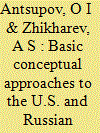

|
|
|
|
|
| Summary/Abstract |
The authors offer a comparative analysis of the approaches taken in Russia (U.S.S.R.) and the United States to the deployment of their strategic antiballistic missile defense systems, and survey the major stages of ABM system development. They show the influence the U.S. military doctrine has exercised on the formation of the country's ABM defense and its intention to take advantage of the new world order to use its ABM system for a different purpose instead - delivering a first nuclear missile strike with impunity.
|
|
|
|
|
|
|
|
|
|
|
|
|
|
|
|
| 2 |
ID:
182636
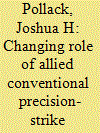

|
|
|
|
|
| Summary/Abstract |
Multiple non-nuclear-armed states in alliances with nuclear-armed states are in the process of acquiring long-range, conventionally armed precision-strike weapons, some of which have potential to contribute to attacks on enemy nuclear forces. This change in the distribution of advanced military technologies has the unintended consequence of giving these non-nuclear-armed states an active role in strategic stability. We provide a theoretical framework for understanding the newly emerging pathways to nuclear use that result. We also investigate perceptions of the role of precision-strike capabilities in six non-nuclear-armed states at various stages in the process of developing these capabilities.
|
|
|
|
|
|
|
|
|
|
|
|
|
|
|
|
| 3 |
ID:
152838
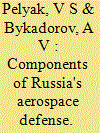

|
|
|
|
|
| Summary/Abstract |
This paper offers a critical analysis of the currently established categories (notions) aerospace sphere and aerospace; shows the physical and legal differences between airspace and outer space; suggests viewing forms of warfare in each of these spheres as categories in their own right, with their own distinctive methods of using various forces and assets
|
|
|
|
|
|
|
|
|
|
|
|
|
|
|
|
| 4 |
ID:
137279
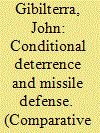

|
|
|
|
|
| Summary/Abstract |
The traditional view of ballistic missile defense is that defensive weapons are destabilizing. This article explains why the more broadly and traditionally accepted classical approach to deterrence is flawed and demonstrates the greater explanatory power and implications of conditional deterrence based on power parity theory. Given the implications that can be drawn from conditional deterrence, this article demonstrates that limited efforts at developing and deploying missile defenses enhance deterrence and reduce the ballistic missile threat in the short term and may also discourage the proliferation of ballistic missiles and weapons of mass destruction.
|
|
|
|
|
|
|
|
|
|
|
|
|
|
|
|
| 5 |
ID:
189139
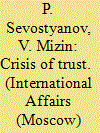

|
|
|
|
|
| Summary/Abstract |
THE OUTBREAK in 2020 of the coronavirus pandemic coincided with a sharp deterioration in relations between Russia and the leading NATO countries, headed by the US. For the first time in the 30 years since the end of the Cold War, officials and experts have started expressing fears about the possibility of an armed conflict between the parties.
|
|
|
|
|
|
|
|
|
|
|
|
|
|
|
|
| 6 |
ID:
146737
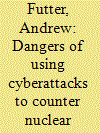

|
|
|
|
|
| Contents |
Top military and defense officials in the United States are currently contemplating plans to use cyberattack capabilities against enemy missile and command-and-control systems as part of a new push for full-spectrum missle defense.
|
|
|
|
|
|
|
|
|
|
|
|
|
|
|
|
| 7 |
ID:
158989
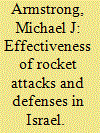

|
|
|
|
|
| Summary/Abstract |
This empirical article studies rocket attacks and defenses in Israel during operations Protective Edge, Pillar of Defense, and Cast Lead, and also during the Second Lebanon War. It analyzes publicly available counts of rockets fired, fatalities, casualties, and property damage. The estimates suggest that interceptor deployment and civil defense improvements both reduced Israel's losses slightly during Pillar of Defense and substantially during Protective Edge. They also imply that interceptor performance during Pillar of Defense may have been overstated. Ground offensives were the most expensive way to prevent rocket casualties. Interceptors were at least as cost-effective as military offensives, and their advantage improved over time. Without its countermeasures, Israel's rocket casualties could have been more than fifty times higher during Operation Protective Edge. These results imply that Israel's rocket concerns were more justified than critics admit, but its military operations were less worthwhile than intended.
|
|
|
|
|
|
|
|
|
|
|
|
|
|
|
|
| 8 |
ID:
117383
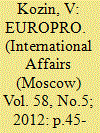

|
|
|
|
|
| Publication |
2012.
|
| Summary/Abstract |
PRESIDENTS Vladimir Putin and Barack Obama in their joint statement signed on June 18, 2012 at Los Cabos, Mexico, in the margins of the summit of the G20 acknowledged differences in assessments of the missile defense issue in Russian-American relations. For several years, it was a persistent stumbling block to the politico-military agenda of the two mightiest nuclear powers. Still, both parties agreed to "continue a joint search for solutions to challenges in the field of missile defense.
|
|
|
|
|
|
|
|
|
|
|
|
|
|
|
|
| 9 |
ID:
120658
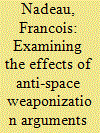

|
|
|
|
|
| Publication |
2013.
|
| Summary/Abstract |
This study examines how political activists are framing the space weaponization debate in Canada and whether their arguments can influence public attitudes and perceptions about the issue. Eighty university students from two undergraduate courses were recruited as participants in a quasi-experiment. One class (n = 38) was exposed to the documentary Masters of Space, an episode of the Canadian Broadcasting Corporation's program The Nature of Things, and another class (n = 42) served as the control group. Pre-test and post-test questionnaires were used to measure the effects of viewing anti-weaponization arguments in the media, while also controlling for the influence of prior beliefs and background characteristics of participants. Results suggest that visually depicting the use of satellite technology in society can convince viewers that satellites are important to their way of life, but not necessarily to the defense of North America. Framing missile defense as a 'space weapon in disguise' also seemed to raise opposition to Canada's participation in continental missile defense. The findings, meanwhile, indicate that viewers respond strongly to the issue of space debris and that mobilizing support for joint military space projects may best be achieved by emphasizing the usefulness of these projects for locating and tracking such debris. In the end, media exposure seemed to help legitimize anti-weaponization arguments based more on rational self-interests than on idealistic beliefs. These findings can have implications for the way space policies are communicated to the public.
|
|
|
|
|
|
|
|
|
|
|
|
|
|
|
|
| 10 |
ID:
016878
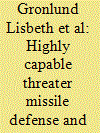

|
|
|
|
|
| Publication |
April 1994.
|
| Description |
3-8
|
|
|
|
|
|
|
|
|
|
|
|
|
|
|
|
| 11 |
ID:
127565
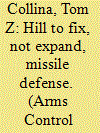

|
|
|
| 12 |
ID:
192456
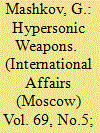

|
|
|
|
|
| Summary/Abstract |
IN RECENT years, hypersonic weapons have become a central topic of discussion around new military technologies affecting international security. Hypersonics are becoming apriority area of military-technological development that some states are using to restore their strategic stability and provide a real deterrence mechanism and others are using to pursue the goal of global dominance. Vast financial, scientific, and technical resources are being invested in the development of missile programs.
|
|
|
|
|
|
|
|
|
|
|
|
|
|
|
|
| 13 |
ID:
110122
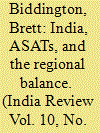

|
|
|
| 14 |
ID:
140979
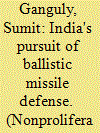

|
|
|
|
|
| Summary/Abstract |
This article analyzes India's efforts to deploy a Ballistic Missile Program (BMD). The article has three objectives. First, it argues that scientific-bureaucratic factors and India's incapacity to deter Pakistan's use of terrorist proxies have driven its quest for BMD. Second, the article also evaluates the current state of India's two-tiered missile defense shield. In spite of various claims on the part of India's defense science establishment, the paper estimates that India still lacks a deployable BMD system and is still far from developing an effective strategy of deterrence-through-denial. Third, the article analyzes the implications of the development of India's BMD system for nuclear stability in South Asia. The article shows how India's BMD capacities, however limited, have indirectly exacerbated the security concerns of India's regional rival, Pakistan.
|
|
|
|
|
|
|
|
|
|
|
|
|
|
|
|
| 15 |
ID:
176354
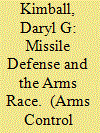

|
|
|
|
|
| Summary/Abstract |
Within weeks of taking office, President Joe Biden and his team will be confronted with dozens of pivotal choices. An under-the-radar but consequential decision facing the new administration will be whether and how to move forward with Trump-era plans to expand the U.S. national missile defense footprint with new sea-based missiles that can shoot down long-range ballistic missiles.
|
|
|
|
|
|
|
|
|
|
|
|
|
|
|
|
| 16 |
ID:
115740
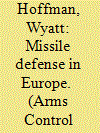

|
|
|
| 17 |
ID:
121696
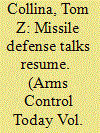

|
|
|
|
|
| Publication |
2013.
|
| Summary/Abstract |
In response to the Obama administration's March decision to cancel plans for long-range missile interceptors in Europe, Russian officials have agreed to join the United States in senior-level talks on missile defense in late April, the Defense Department has confirmed.
|
|
|
|
|
|
|
|
|
|
|
|
|
|
|
|
| 18 |
ID:
129132
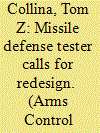

|
|
|
|
|
| Publication |
2014.
|
| Summary/Abstract |
The Defense Department's chief weapons tester called in January for the redesign of a key component of the U.S. system intended to intercept long-range missiles launched from North Korea or Iran, raising questions about the department's plans to expand the current system. J. Michael Gilmore, the Pentagon's director of operational test and evaluation, wrote in his annual report, released Jan. 29, that recent test failures of the U.S. ground-based interceptor (GBI) system raise concerns about the system's reliability and suggested that the missile's exoatmospheric kill vehicle (EKV) be redesigned to assure it is "robust against failure." Echoing Gilmore's view, Frank Kendall, undersecretary of defense for acquisition, technology and logistics, told a Feb. 25 conference in Washington, "We've got to get to more reliable [missile defense] systems." Merely "patching the things we've got is probably not going to be adequate. So we're going to have to go beyond that," he said. The EKV plays a central role in the missile defense mission. It is lifted into space by a booster rocket and then uses its onboard sensors to locate an incoming enemy warhead and destroy it on impact. U.S. officials have compared the task to hitting a bullet with another bullet.
|
|
|
|
|
|
|
|
|
|
|
|
|
|
|
|
| 19 |
ID:
177622
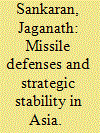

|
|
|
|
|
| Summary/Abstract |
The contention over the quantity and quality of regional missile defenses forward-deployed by the United States in the Asia-Pacific region animates much of the US–China disagreement about strategic stability. The Chinese argue that the deployed assets exceed reasonable defensive requirements and suggest that if these missile-defense deployments continue, they will be forced to increase the size of their nuclear arsenal. In disagreement, the United States claims that regional missile defenses are defensive by design, limited in scope, and necessary to defeat a North Korean missile campaign. In this article, a series of simulation experiments were developed to empirically test these opposing arguments over missile defenses and strategic stability. The simulations indicate that current deployments are necessary for defense and proportional to the threat. The analysis also argues that current deployments do not possess the ability to alter the US–China strategic nuclear balance significantly. The article concludes with a discussion of other subjective aspects of national security that may explain Chinese concerns and explore possible ways to reassure China.
|
|
|
|
|
|
|
|
|
|
|
|
|
|
|
|
| 20 |
ID:
122941
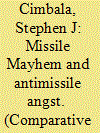

|
|
|
|
|
| Publication |
2013.
|
| Summary/Abstract |
The political context for nuclear arms reductions, as between the United States and Russia, seemed to stall in 2012 and appeared uncertain as to possible progress during the second term of U.S. President Barack Obama and the third term of Russian President Vladimir Putin. The prospect of a successor agreement to New START that would reduce the numbers of U.S.- and Russian-deployed strategic nuclear weapons to even lower levels was further clouded by Russian objections to U.S. and NATO plans to deploy missile defenses in Europe. The present study considers the political and military aspects of some prospective Obama approaches to post-New START nuclear arms reductions and performs pertinent analysis to consider the relationship between offensive nuclear arms reductions and missile defenses going forward.
|
|
|
|
|
|
|
|
|
|
|
|
|
|
|
|